Agency Performance: What to Measure (Besides ROI) on DashThis

This isn’t another post on the top 10 performance-based agencies with cutting-edge solutions and proven track record.
Rather, we’re going to talk about the metrics you should measure today.
Besides ROI, of course.
While there’s nothing wrong with evaluating your agency’s performance from an ROI standpoint, it doesn’t really tell you what works (and what doesn’t) right down to the granular level. Not great if you want to replicate what you did previously and experiment with new ideas based on what you learned.
You gain a complete picture of your agency when you track other metrics alongside ROI.
This guide reintroduces some of the most common metrics if you don’t know where to begin. To make it more valuable, we also share the metrics agency marketers initially overlooked but now prioritize today.
- 4 Reasons to Dive Deeper into Your Agency Performance if You’re Only Measuring ROI
- Top 27 Agency Performance KPIs to Evaluate the Outcomes of Your Marketing Goals & Revenue Growth
- Alternatively, Track These Performance Metrics on Dashboards (a Quick Tutorial on How DashThis Works)
- Spend Less Time on Your Digital Agency Performance Reports Today.
4 Reasons to Dive Deeper into Your Agency Performance if You’re Only Measuring ROI
Having worked with dozens of performance marketing agencies across 120+ countries, we boil it down to these reasons:
- Identify what works and what slips through the cracks: “What insights did we gain from last month’s successful ad, so that we can replicate it in the next performance marketing campaigns?” “Open rates are high, but click-throughs are abysmal… How can we get our subscribers to click through the onboarding email marketing campaign?” To answer questions like these, you need to dive deeper into acquisition and engagement metrics, not only ROI.
- Turn one-time clients to extreme loyalists: Clients don’t just look for a return on investment in agency partnerships. They also value data transparency and a realistic action plan for their digital marketing campaigns. Document your data-driven agency results and share them with stakeholders to back up the impact of your work.
- Compare performance to find your best-fit clients: Stack up your client results against each other to uncover where you do your best work. Can’t figure out if you should go all in between B2C vs. B2B marketing? Or eCommerce vs. retail? Venture-funded or late-stage startups? Or content marketing vs. paid social? Metrics like revenue per client, delivery margin, and project profitability offer a fuller picture.
- Understand profitability and growth: If the cash in your bank account is rising, surely that shows a high ROI, right? RIGHTTTTT? *inserts Anakin Padme meme* Not exactly, as it doesn’t fully capture hidden costs. You need to track other metrics like billable hours, revenue per employee, etc. to stay ahead and profit.
Top 27 Agency Performance KPIs to Evaluate the Outcomes of Your Marketing Goals & Revenue Growth
This section shares some of the most common and overlooked agency KPIs and metrics. Measure them today for a bird's-eye view of your overall agency performance.
Client acquisition metrics
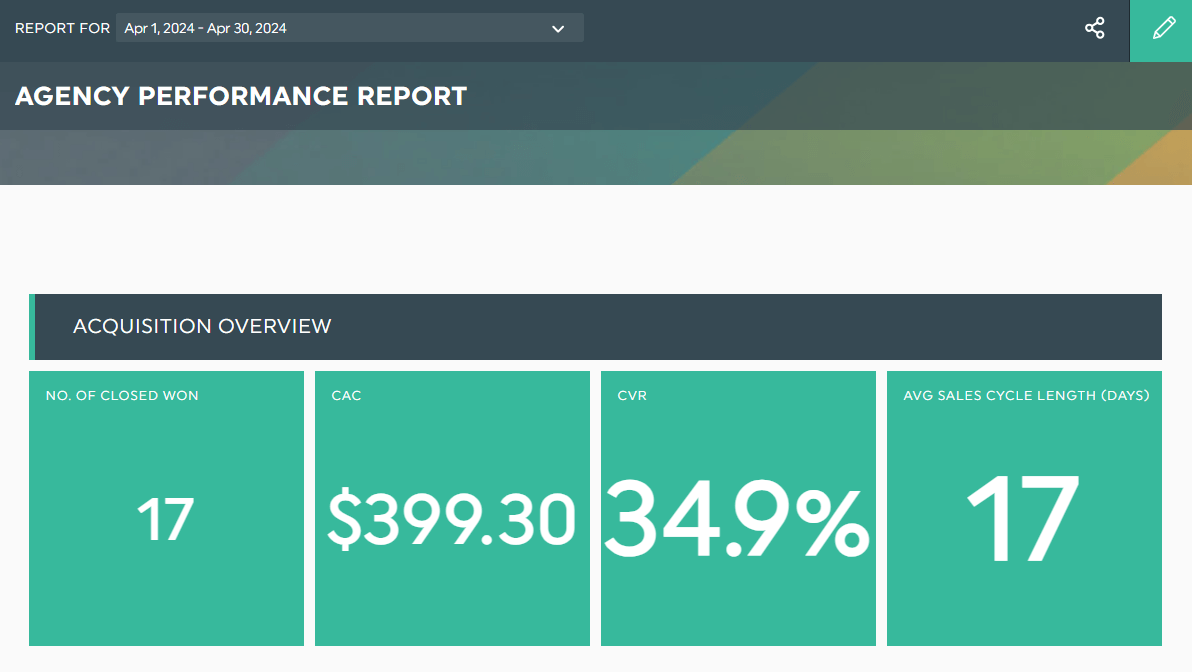
How do you attract top-notch clients consistently? Are you winning enough deals to sustain your agency? How do your lead generation efforts compare from the previous period? These metrics provide the right answers quickly.
COMMON METRICS IF YOU DON’T KNOW WHERE TO BEGIN:
- Number of MQL/SQLs
- Count of closed won deals
- Customer acquisition cost (CAC)
- Customer lifetime value (CLTV)
- Conversion rate (CVR)
OVERLOOKED METRICS YOU SHOULD PRIORITIZE:
(i) Contractor acquisition velocity
As the demand for your digital marketing services grows, you'll need more contractors or freelancers to bring projects to life.
During the early days of business, Contentellect, an agency that specializes in SEO, underestimated the importance of writer acquisition velocity as a leading indicator. The lack of elite writers created a production bottleneck, inhibiting the marketing company's growth.
If you're facing a similar problem, says CEO Jason Smit, focus more on "casting even wider nets and automating your recruitment funnel."
But don’t go overboard, as high headcount can be misleading, according to Sean Begg Flint, Founder and Director of Position Digital.
Flint shares with us, "It can sometimes just mean increased overheads without proportionate growth in value."
Your best bet is tracking these metrics alongside profitability and efficiency.
(ii) Sales cycle length
Ignoring your sales cycle length, says Gabriel Lukov, Head of Inbound Growth at Businessmap, "masked inefficiencies and bottlenecks in your process."
What Lukov means is if you don’t track how long it usually takes to win an account, you’ll never know what's potentially slowing down the cycle, let alone fixing it to drive more sales.
To speed up the buying journey, identify the bottleneck(s) and fine-tune your sales process.
For example, if your sales reps are cherry picking leads, we can deduce they’re struggling to identify sales-ready leads (that’s the bottleneck!). In this case, you’ll want to invest in a contact scoring platform to pinpoint qualified leads automatically.
(iii) Proposal win rate
Tracking your proposal win rate helps you identify your best clients today.
One agency, which offers web design, SEO, PPC, and social media marketing solutions, discovered its top two industries based on the response.
"Proposals for e-commerce and SaaS clients converted at twice the rate of other industries," says Marshal Davis, the President of Ascendly Marketing.
On his plans to focusing more on these sectors, Davis says:
"When we develop deep expertise and tailored services for these niches, we expect to increase our overall proposal win rate by at least 30% in the coming year."
(iv) Client referral rate
Clients frequently referring new businesses to your agency are your most loyal and profitable.
"Tracking and optimizing client referral rate lower our acquisition costs and attract clients who are already pre-sold on our services," adds Davis.
Experiment with different tactics to encourage these referrals. Whether it's an incentive or direct ask, having clients refer new customers makes, to quote Davis, "an extremely powerful growth driver."
Client retention metrics
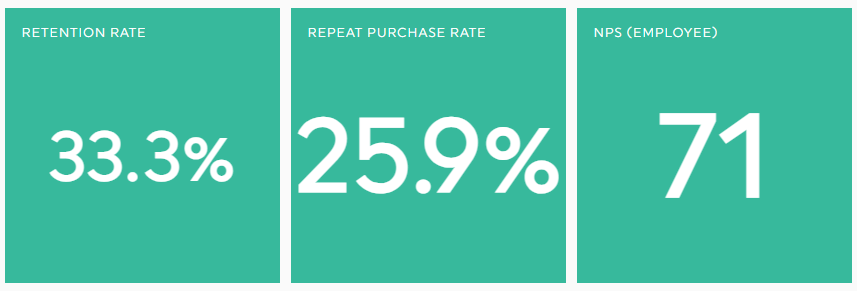
You're leaving money on the table if you're not investing in retaining clients. Yes, even when you're selling more. The following metrics determine if you need to restructure your retention strategy.
COMMON METRICS IF YOU DON’T KNOW WHERE TO BEGIN:
- Client churn
- Client satisfaction
- Net Promoter Score (NPS)
- Repeat purchase rate
- Client retention rate
OVERLOOKED METRICS YOU SHOULD PRIORITIZE:
(i) Employee net promoter score (eNPS)
Agencies with high eNPS scores not only performed better for clients but also drove greater retention rates.
"Satisfied personnel are more willing to go above and beyond," explains Phil Strazzulla, the Founder of SelectSoftware Reviews, "It fosters innovation and strengthens client relationships."
To consistently improve this metric, Strazzulla recommends focusing on your agency's working culture.
Here are some unique ideas, according to the founder:
- Introduce an innovation challenge where employees present new project ideas. SelectSoftwareReviews hosts it quarterly and awards employees prizes if their ideas are implemented.
- Launch 'Career Growth Fridays' where team members dedicate a few hours learning new skills or working on personal growth projects
- Increase frequency of one-on-one meetings between employees and supervisors. This promotes ongoing communication, increasing overall engagement and satisfaction.
By investing directly in your team's happiness and professional growth, adds Strazzulla, client satisfaction and retention will eventually rise.
Operational metrics
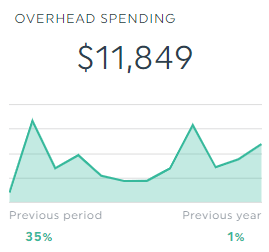
Your operational metrics give you a snapshot of your day-to-day operations and their impact on revenue growth. These metrics may not be as "sexy" as acquisition or retention, but they're just as important.
COMMON METRICS IF YOU DON’T KNOW WHERE TO BEGIN:
- Average billable rate
- Delivery margin
- Overhead spending
OVERLOOKED METRICS YOU SHOULD PRIORITIZE:
(i) Billable hours vs non-billable hours
Clocking in extra hours for clients isn't necessarily a good thing, especially when it involves non-billable work.
Like creating reports manually.
Not only do you barely break even despite the large paycheck, but you also risk neglecting more important activities for other clients.
One way to prevent yourself from falling into this trap is by stacking up billable hours against non-billable hours.
"This metric wasn't our primary focus initially," divulges Gianluca Ferruggia, the general manager at DesignRush, a B2B marketplace that matches businesses with their ideal digital marketing agency. "But we later realized its substantial impact on overall operational efficiency."
A potential solution to reduce non-billable hours? Using automation.
For instance, if you want to gain back hours of your time in manual reporting, invest in a reporting tool like DashThis. That way, you can gather your entire marketing data across multiple channels into one report, automatically.
(ii) Project duration
This metric seems like a no-brainer, but agencies that focus more on deliverables than time frame may overlook it.
That's exactly the case for Wytlabs.
After analyzing its operational trends, the performance marketing agency discovered: shorter project durations correlated with higher client satisfaction and more repeat businesses.
"We shifted our focus towards efficiency," shares Marc Bishop, the Director.
By improving the agency's project management through training and tools, Bishop and his team streamlined their processes and advanced collaboration, eventually shaving hours off the timeline.
"This approach not only speeds up project delivery but also increases our capacity to handle more projects simultaneously."
Financial metrics

These outcome-minded metrics determine if your agency is getting the returns management is looking for.
COMMON METRICS IF YOU DON’T KNOW WHERE TO BEGIN:
- Project profitability
- Gross margin
- Net profit
- ROI
- Accounts receivable aging
OVERLOOKED METRICS YOU SHOULD PRIORITIZE:
Payroll is likely your largest expense since your agency’s main input revolves around people's time.
Back when Hennessey Digital was growing, management would give the green light to whomever asked for a new hire without a second thought.
But after tracking the metrics below, the agency, which offers a varied range of performance marketing services, realized their headcount and payroll costs were growing more rapidly than revenue.
(i) Revenue per employee
(ii) Payroll as a percentage of revenue
"We implemented far more rigorous hiring standards to ensure we needed the role before we began recruiting," says Scott Shrum, President and COO at the full-service agency.
Before hiring a new employee, says Shrum, the hiring manager should answer the five methodology questions below:
- "What's the work being done right now?"
- "How much in terms of "person hours" are we spending on the work?"
- "How much capacity does the current team have?"
- "What is the performance of the current team like?" (Is everyone working at their ideal level of effectiveness today? Can anyone improve?)
- "What has already been tried before?"
Your answers will determine if you actually need a new process, software tool, or training instead of a new hire.
Shrum also recommends tracking the metrics on a scorecard and regularly sharing it with senior leaders.
"It helps them see the big picture and play a part to contain the costs."
Alternatively, Track These Performance Metrics on Dashboards (a Quick Tutorial on How DashThis Works)
While scorecards measure your progress towards business goals, marketing dashboards (like the ones created on DashThis) monitor your metrics in real time.
Gather your entire data across different marketing channels into one beautiful report automatically. This way, you analyze your overall performance in a single interface, distilling agency insights and spotting growth opportunities quickly.
Here's how it works:
- Select a pre-made report from 40+ templates
- Connect your data source(s) with DashThis
- Pick your metrics in Preset Widget (note: DashThis boasts pre-built popular metrics; treat them as a starting point if you don’t know where to begin)
DashThis will automatically gather your entire data into your report. Drag and drop them to form a cohesive look (e.g., number of leads from SEO in one section and LinkedIn Ads in another).
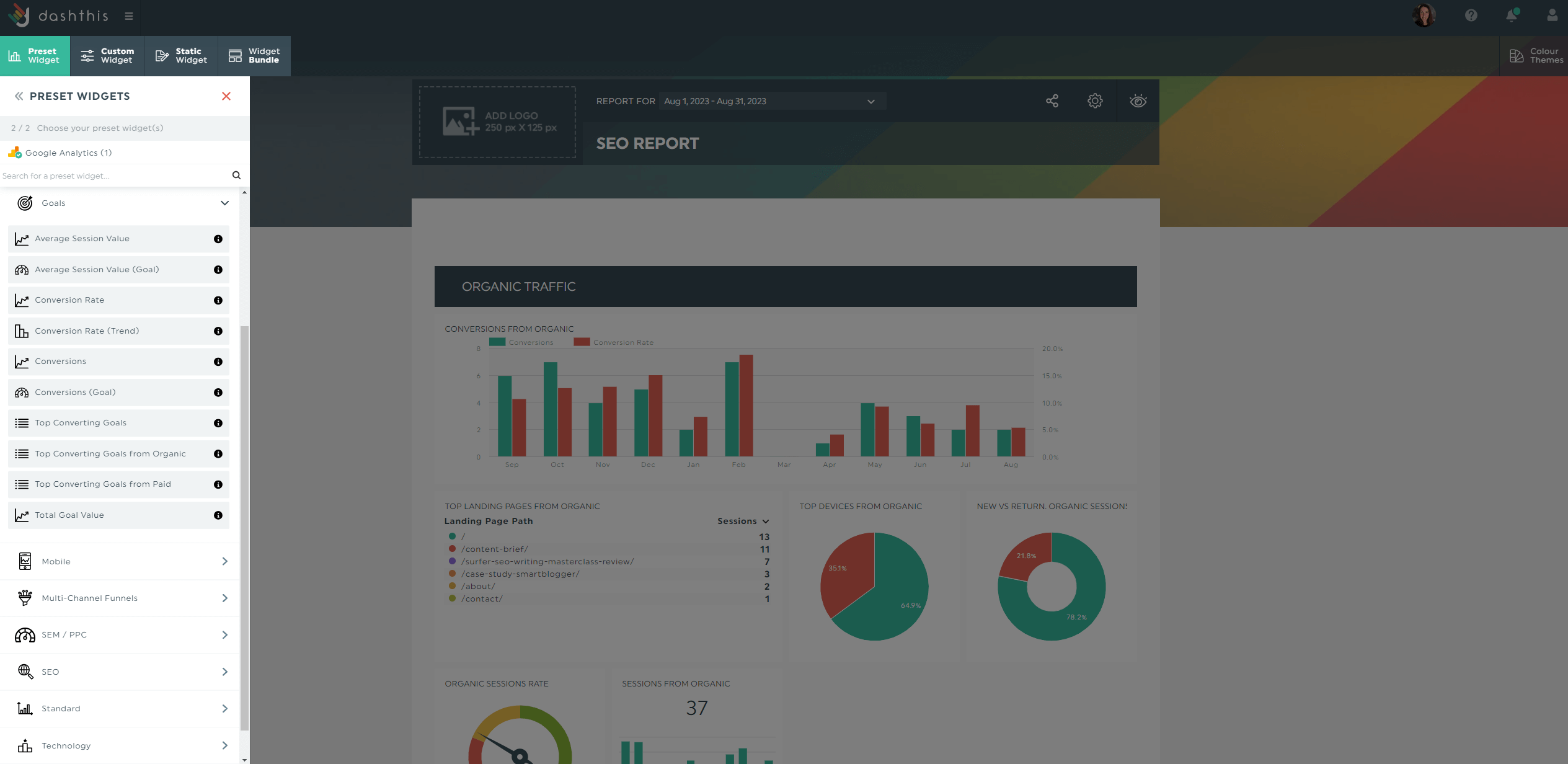
Customize the report to include the KPIs and metrics specific to your agency.
Suppose you want to include brand equity (e.g., brand awareness) in your advertising agency performance dashboard. The problem? The CFO isn't convinced how this metric impacts sales.
Try our built-in notes to make your case:
note: DashThis is primarily a marketing reporting tool. To connect a brand tracking tool, download your branding metrics as a CSV file and upload it to our platform.
- Upload your custom data via the CSV file manager
- Adjust the graph as you desire for the metric
- Click Add Note
Explain it accordingly.
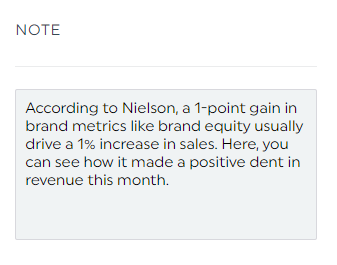
Click Save.
Our built-in notes widget also comes in handy when you:
- Define what marketing acronyms mean to non-marketing professionals (e.g., SEM > search engine marketing, PPC > pay-per-click, CRO > conversion rate optimization, SEO > search engine optimization)
- Back up your statements or suggestions with cold, hard proof (e.g., statistics to highlight how poor web design impacts user experience on landing page, messaging in successful display ads can be replicated in other channels like social media and affiliate marketing)
- Provide context for erratic results (e.g., temporary spike in traffic is caused by viral media strategy)
Once you’re customized the report, send it via automated email dispatch:
- Hover to the Sharing Options icon on the top right
- Click Share by Email
- Set the dashboard period and frequency
- Click Schedule
This email dispatch sends your agency performance report to all stakeholders (e.g., marketing team, project manager) according to your preferred schedule, automatically.
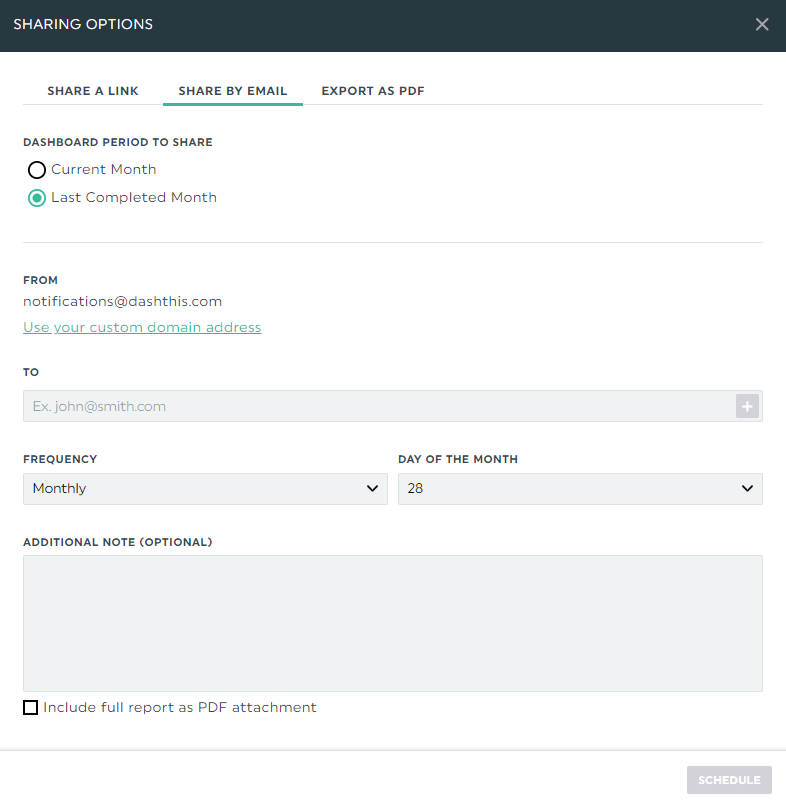
Alternatively, share it via a URL link or print in as a PDF.
Now that you can automate your agency performance reports in the blink of an eye, you can finally draw better insights, spend more of your days on billable work, and gain back hours of your time.
DashThis is the easiest reporting tool with unlimited capabilities–no matter what plan you’re on. Grab your entire data from 40+ marketing channels into one beautiful report.
Start your free 15-day trial to automate your agency performance reports today.
Business executive report template
Gather all the metrics that matter most to management into this report. It'll help you gauge your marketing efforts, justify investment for the next performance marketing strategy, and illustrate the impact of your work.
Combine these financial metrics with any online marketing channel(s) of your choosing. Whether it’s highlighting how:
- Programmatic in-app retargeting reactivates dormant users in your various mobile apps,
- Showing how influencer marketing maximizes reach, or
- Examining how case studies attract your target audience and convert them to high-value clients,
…or [insert your use case], this full-funnel attribution report got you covered.
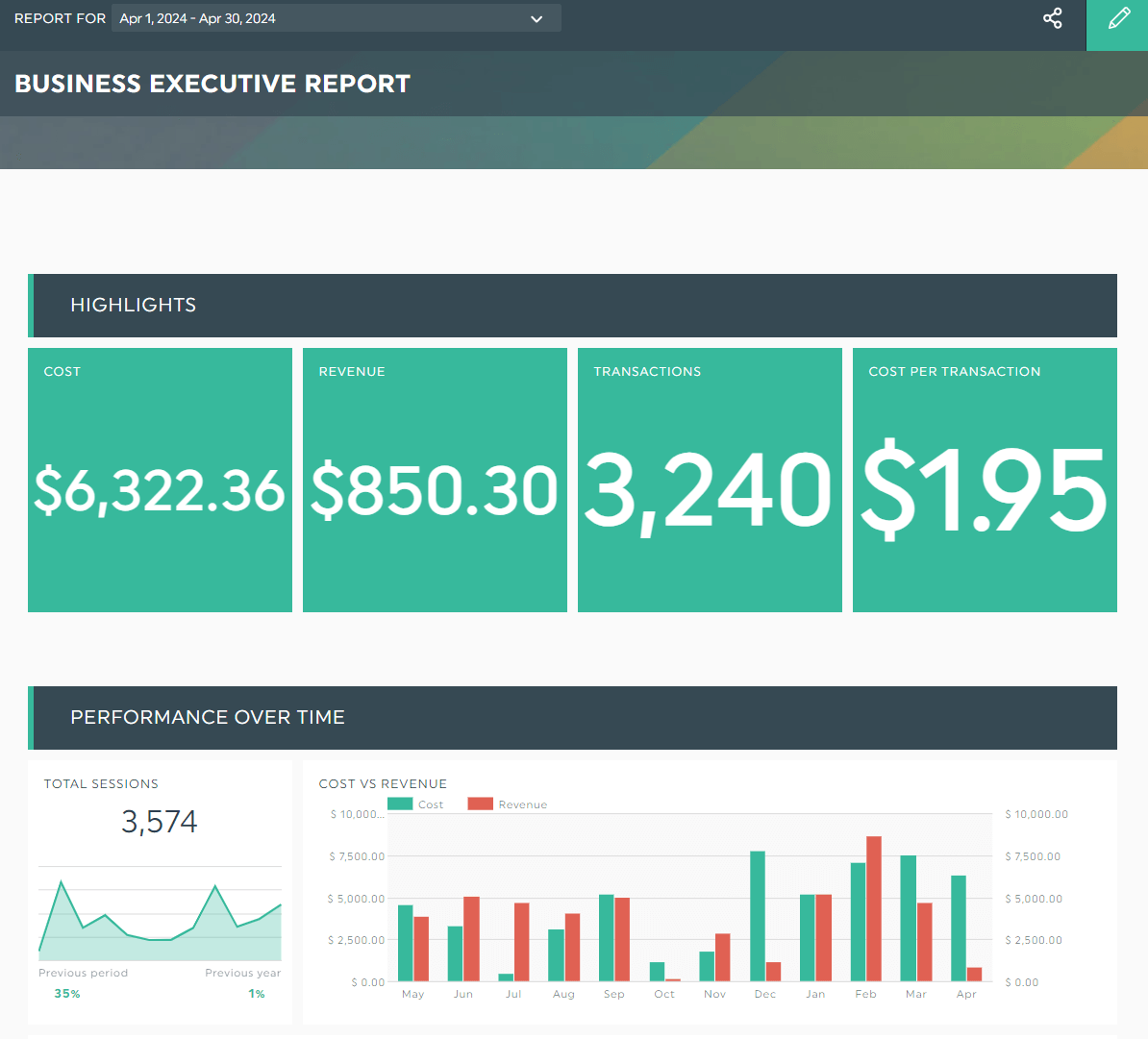
Grab this FREE business-centric digital marketing strategy report with your own data!
Spend Less Time on Your Digital Agency Performance Reports Today
ROI is an important outcome-based metric, but it shouldn’t be your only focus.
Track these metrics across acquisition, retention, operation, and finances. You’ll gain a much more complete picture of what’s happening in your agency and make better decisions.
Better yet, track it via DashThis, the easiest reporting tool.
Grab your entire data across your favorite marketing channels into one beautiful dashboard. Combine your CEO-approved metrics with your favorite marketing platforms (e.g., Google Ads, TikTok) in a single interface.
You’ll spot opportunities for your next marketing plan easily.
Pricing starts at $42/month when billed annually. Start your free 15-day trial today.
Ready to start tracking your agency performance?
Read More
Don’t miss out!
Automate your reports!
Bring all your marketing data into one automated report.
Try dashthis for free

